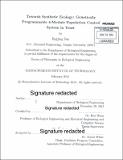Towards synthetic ecology : genetically programmable 4-module population control system in yeast
Author(s)
Sun, Jingjing, Ph. D. Massachusetts Institute of Technology
DownloadFull printable version (18.51Mb)
Other Contributors
Massachusetts Institute of Technology. Department of Biological Engineering.
Advisor
Ron Weiss.
Terms of use
Metadata
Show full item recordAbstract
Communities of microorganisms are found nearly ubiquitously on earth. They survive and proliferate through interactions within and between microbial species, which are mediated by the exchange of small signaling modules. Understanding how they regulate the interactions is both crucial and challenging, with applications including industrial biotechnology, human health and environmental sustainability. In microbial ecology, researchers have been trying to culture pure and mixed species in different conditions to elucidate the rules behind the interactions. However, the studies have been complicated by multiple variables at both the genotype and phenotype levels. To address these challenges, I demonstrate a synthetic ecological system as a proof of principle to observe microbial population level behaviors. Using a formalized design process and engineering principles, I design and construct a synthetic multi-module ecological system for population homeostasis. The synthetic ecological system consists of four functionally distinct modules - quorum sensing, high threshold killing, low threshold killing, and intermediate rescuing modules. The system is able to maintain the yeast population within a programmable range in liquid culture. However, when the same system is studied in solid medium, heterogeneity in growth rate and population size is observed. To further study the heterogeneity issue in solid medium, I develop a cell deposition platform to evaluate sub-population level or even single-cell level behavior. With a commercial Nano eNabler machine, cells with pre-defined patterns are deposited on agarose surface. This technique can be used to study microbial communities in a spatially distributed fashion.
Description
Thesis: Ph. D., Massachusetts Institute of Technology, Department of Biological Engineering, 2014. Cataloged from PDF version of thesis. Includes bibliographical references (pages 155-165).
Date issued
2014Department
Massachusetts Institute of Technology. Department of Biological EngineeringPublisher
Massachusetts Institute of Technology
Keywords
Biological Engineering.